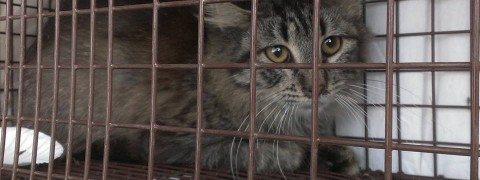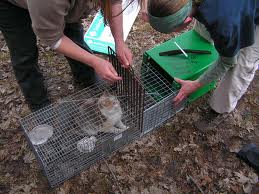Iowa Humane Alliance is currently not taking Community Cat walk-ins at this time.
What is Trap-Neuter-Return?
Trap-Neuter-Return programs are a humane alternative to mass euthanasia of the free-roaming cats living in our environment and, when well-managed, are more effective at reducing the population.
While tame free-roaming cats may be handled, many free roaming cats are feral (wild) or semi-feral. Those cats that cannot be safely handled are humanely Trapped, Neutered, and Returned (TNR) to their outdoor homes. A caregiver provides shelter, food, water and overall monitoring of the cats, and because they are altered, the birth of unwanted kittens decreases. TNR has proven to be the most cost effective and humane method to decrease cat overpopulation in free-roaming cats.
Getting Ready
- Ensure you have the financial resources or funding for your TNR project and that you are aware of IHA’s appointment policies.
- Establish a feeding schedule. Feed the cats at the same time and place each day, for a few days to a week prior to trapping. You will eventually place the traps in this area, so make sure it is a safe and level location.
- If you need live-humane traps, you may check them out from the IHA Regional Spay/Neuter Clinic. We require a $50 deposit for each trap, which will be refunded when you return them.
- You may bring up to 2 trapped cats per household in the morning without an appointment. Drop off time is 7:15 AM – 10 AM Monday – Thursday for trapped cats.**
- If you plan on trapping more than 2 cats, an appointment is required. With advance planning, we can accommodate at many at 35 – 40 cats on one day. If you are working with a large number of cats, doing them all at once is by far the most effective way to curb the population growth of the colony. Please call the clinic in advance to schedule. We can help you with a strategy to complete the project!
- Be sure to alert the neighbors that you will be trapping. Most will be very grateful. Ask them to keep their own cats inside on the days that you trap. Also ask your neighbors if their cats are spayed/neutered.
**PLEASE DO NOT TRAP A CAT UNLESS YOU CAN TAKE IT TO THE CLINIC WITHIN 24 HOURS.
Supplies
- Live-humane traps
- Cans of tuna, sardines, or mackerel in oil, or other enticing bait.
- Newspaper or a lightweight towel to line the bottom of each trap.
- A large towel or cloth to cover each trap. This will calm the cat once in the trap.
- Lids or scraps of cardboard to hold the bait.
- Vehicle to transport the cats and a tarp or sheet to protect your vehicle.
Withholding Food
You must withhold ALL food from the cats you intend to trap for 24 hours before trapping. This may involve asking neighbors to withhold food as well. This will ensure that the cats are hungry enough to enter the traps. Also, surgery is ideally performed on cats with empty stomachs. You should always provide clean drinking water.
Start Trapping
-
- Make sure that you know how to work the trap BEFORE you begin to trap.
-
- It is helpful to trap at the same time that you would normally feed the cats. They will be hungry and waiting for you to bring food.
-
- Line the bottom of the trap, to the end of the trip plate, with newspaper or pillowcase.
-
- Place a tablespoon of bait on your lid or cardboard. Set it on the ground where you intend to place the trap. Set the trap on top of it so that the bait comes up through the bars at the very back of the trap. Drizzle some juice from the bait along the trap toward the entrance in a zigzag pattern. Place about a half teaspoon of bait in the middle of the trap, near the trip-plate, and another half teaspoon a few inches from the entrance of the trap. It is important not to leave too much food in the front and middle, as this may satisfy the cat before the trap is set off.
-
- Set the traps in the usual feeding time and place.
-
- If you are using multiple traps, stagger them, and place them facing in different directions, with at least a couple of feet in between each trap.
-
- Move quietly and slowly and try to remain relaxed, so your behavior will not frighten the cats away.
- Set each trap and cover it with a large towel or sheet.
- Offer food to remaining cats once you are done trapping for the day.
- Leave the area quietly. If the cats are used to being called for their food, do so before you leave. DO NOT LEAVE THE TRAP(S) UNATTENDED. Find a place away from the trap (in your car, house, behind a building) and wait for the cat to go in. A cat left alone in a trap for even short periods of time can be treated badly by other people or animals. They are also vulnerable to the weather. If you are trapping at your home, remember to trip or remove the trap before you go to bed at night.









